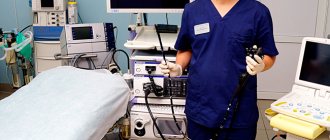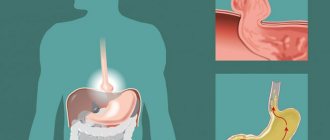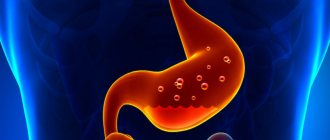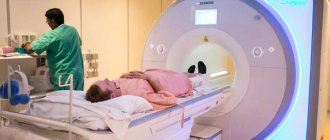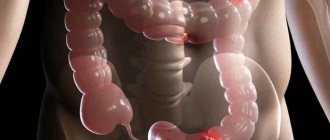General information
Barrett's syndrome was named after the British surgeon who first described ulcers and cancerous degeneration of the lower esophagus. This pathology develops as a complication of gastroesophageal reflux disease (GERD) and is distinguished by the presence in the epithelial layer of the food tube connecting the mouth to the stomach, not flat multilayered, but unusual for the norm - cylindrical small intestinal epithelium.
The disease is considered chronic. Tissue degeneration is asymptomatic, the exact mechanism is not fully understood, but it occurs in the sequence - metaplasia - dysplasia - cancer. Current recommendations boil down to regular endoscopic examinations to identify lesions in the early stages and prevent neoplastic formations.
Causes and risk factors for the development of pathology
The causes of Barrett's esophagus are:
- heredity;
- gastroesophageal reflux disease (stomach contents enter the esophagus, irritating its walls);
- duodenogastric reflux disease (DGR) - (the contents of the duodenum enter the stomach);
- presence of Helicobacter pylori infection Source: Vasiliev Yu.V. Barrett's esophagus: etiopathogenesis, diagnosis, treatment of patients / Yu.V. Vasiliev // Difficult patient. - 2006. - No. 7. - T. 4. - P. 29-37. Shumkova E.N. The role of Barrett's esophagus in oncological pathology / E.N. Shumkova [and others] // Bulletin of KazNMU. - 2013. - No. 2. - P. 296. ;
- the impact of various medications that damage the stratified squamous epithelium of the esophagus Source: Vasiliev Yu.V. Barrett's esophagus: etiopathogenesis, diagnosis, treatment of patients / Yu.V. Vasiliev // Difficult patient. - 2006. - No. 7. - T. 4. - P. 29-37. ;
- bad habits (smoking, frequent drinking of alcohol);
- poor nutrition, excess weight;
- ulcer;
- previous surgical manipulations on the stomach.
Risk factors for developing Barrett's esophagus include middle-aged age and male gender. In most patients, this pathology was diagnosed at the age of 50-60 years, in men 3-4 times more often than in women Source: Kashin S.V. Barrett's esophagus: modern diagnostic capabilities, drug therapy and reducing the risk of cancer / S.V. Kashin, I.O. Ivanikov // Experimental and clinical gastroenterology. - 2009. - No. 2. - P. 90-98. .
Pathogenesis
Barrett's disease develops as a result of the process of metaplasia of cells located at the bottom of the esophagus in front of the stomach under the influence of chronic acid damage and esophagitis , causing inflammation and erosive-ulcerative changes. Metaplasia of the esophagus comes down to the replacement of squamous epithelium with columnar epithelium, characteristic of the stomach, as a structure more capable of withstanding the effects of gastric acid. In this case, as a result of reparation, goblet and other columnar cells characteristic of metaplastic transformation are found.
Metaplasia due to GERD
In the future, the pathology can lead to mild or severe dysplasia in the form of enlargement of nuclei, changes in the nuclear and cytoplasmic ratio, increased mitotic activity, cytological and nuclear polymorphism. This occurs under the influence of hydrochloric acid, which increases the activity of enzymes - protein kinases , which initiate mutagenic and proliferative processes in cells while simultaneously inhibiting apoptosis in the area of the affected epithelium.
Operation
If metaplasia, as well as mild and moderate dysplasia is detected, we are talking about a benign process, in which case organ-preserving surgery is possible. If severe dysplasia or squamous cell carcinoma, a malignant disease, is diagnosed, Lewis surgery is performed. If areas of high-grade neoplasia with a likelihood of invasion are found in the area of metaplasia, then RFA can be performed. In case of deep damage, radical removal of a section of the esophageal mucosa using an endoscopic method is indicated.
Our clinic performs laparoscopy using the unique technique of Professor Puchkov. During the operation, a hiatal hernia is repaired, a physiological valve is created between the esophagus and the stomach, and pathological reflux is eliminated. Recovery occurs in a short time; already six months after the operation there is no need to take medications, there is no need to adhere to any strict diets, and for the rest of your life. The number of relapses has been reduced to 2%. Thanks to the use of modern materials during surgery, after healing there are no scars on the skin of the abdomen, only 3-4 incisions 5-10 mm long, which become invisible over time. By the way, in the clinic it is possible to simultaneously perform operations on the abdominal and pelvic organs during one anesthesia. In one operation, the clinic’s specialists can relieve patients from several pathologies at once.
Classification
Barrett's disease can vary depending on the type of pathological process condition:
- Erosive type - leads to the formation of erosive or erosive-ulcerative defects in the mucous membranes of the esophagus, mainly in the lower sections.
- Cylindrical cell metaplasia of the esophagus is a type of pathology that is characterized by a persistent condition even when external negative factors are eliminated and leads to malignancy - the degeneration of formations into malignant ones.
- Dysplasia – causes disruption of the structure of mucosal cells, their premature aging and uncontrolled division.
Depending on the area of localization of metaplasia, they are distinguished:
- Metaplasia of the long segment of the esophagus.
- Detection of single-layer prismatic epithelium in a short segment, that is, in an area 3 cm distant from the transition of the esophageal tube to the fundus of the stomach.
- Re-epithelialization of lesions of the cardiac part - the area located immediately at the transition of the esophagus to the stomach.
Barrett's syndrome
To date, optimal treatment methods for Barrett's syndrome, allowing for complete regression of clinical manifestations and histological changes, are under development.
Therapeutic tactics for Barrett's syndrome depend on the stage of the disease and the severity of symptoms. For mild and moderate epithelial metaplasia, treatment consists of eliminating the clinical manifestations of gastroesophageal reflux, restoring the normal epithelial cover of the esophagus, and preventing malignant degeneration.
Non-drug treatments and medications are used to treat GERD. Non-drug methods of influence include normalizing the daily routine and nutrition, treating obesity, sleeping in a semi-sitting position, giving up bad habits, tight belts, and excessive physical activity.
Drug therapy includes antisecretory drugs (proton pump blockers, if they are intolerant - H2-histamine receptor blockers); antacids; prokinetics (metoclopramide, domperidone). The greatest effect of drug treatment is achieved by combining these three groups of drugs. If there is reflux of bile into the esophagus, ursodeoxycholic acid is prescribed. If there are complaints about a feeling of bloating and fullness in the stomach after eating, enzyme preparations that do not contain bile acids are used.
Studies in the field of gastroenterology show that in patients who received antisecretory and antacid drugs for a long time before the diagnosis of this disease, the segment of Barrett's esophagus is significantly shorter, and the level of metaplasia is significantly lower than in patients who did not use these medications.
Indications for surgical treatment of Barrett's syndrome include esophageal strictures, a high degree of metaplasia, treatment-resistant esophageal ulcers, bleeding from the esophagus, and a high risk of malignancy. Endoscopic techniques are used to destroy metaplastic epithelium: photodynamic, laser, argon plasma therapy; electrocoagulation and cryodestruction; endoscopic resection of the esophageal mucosa.
Forecast and prevention of Barrett's syndrome
The prognosis for identifying Barrett's syndrome is unfavorable. In patients with a long segment of metaplastic esophagus, esophageal cancer is diagnosed in 0.5-1% of cases; with a short segment of metaplasia, the incidence of malignancy is significantly lower. With a short segment of Barrett's syndrome and a low degree of metaplasia, complete regression of the endoscopic picture is possible against the background of conservative treatment in 8% of patients. Antireflux surgery leads to recovery in approximately 4% of patients.
It is possible to prevent the development of Barrett's syndrome only through timely diagnosis and treatment of gastroesophageal reflux disease. Specific prevention of Barrett's esophagus has not been developed. Patients with Barrett's syndrome, even after effective conservative and surgical treatment, require annual endoscopic examination with epithelial biopsy.
Symptoms
The process of metaplastic transformation of esophageal epithelial cells itself does not have symptoms, but is usually associated with:
- with frequent and prolonged heartburn , belching with sour contents;
- with soreness, problems and pain when swallowing as a result of dysphagia ;
- with bloody vomiting;
- with pain and discomfort in the pit of the stomach (in the epigastric region), where the esophageal tube connects to the stomach pouch;
- with frequent attacks of nausea and regurgitation after eating;
- with difficulty breathing and an unreasonable cough;
- with a decrease in body weight.
Symptoms of Barrett's esophagus
Barrett's syndrome has no specific clinical manifestations. Almost all the symptoms of this disease of the esophagus are “borrowed” from GERD (gastroesophageal reflux). The following signs allow the disease to be associated:
- heartburn that occurs frequently and lasts longer than usual;
- dysphagia - difficulty swallowing, which is accompanied by pain in the pit of the stomach;
- vomiting with blood.
Due to constant pain when eating, a patient who has Barrett's esophagus begins to lose weight. This does not happen at the moment when GERD turns into metaplasia of the esophagus, but later, when areas of mucous membrane damaged by gastric juice increase and encircle the lower part of the esophagus at the point where it passes into the stomach.
Tests and diagnostics
To make a diagnosis of Barrett's esophagus, confirmation is necessary after:
- conducting esophagoscopy and multilevel four-square biopsy for chromoendoscopic examination with methylene blue and identification of goblet cells;
- radiographic studies to detect esophageal ulcers or stenosis with peptic ulcers in the area of the stricture;
- esophagomanometry , which allows to identify changes in the condition of the esophageal sphincter;
- intraesophageal 24-hour pH-metry - to determine the acidity of gastric juice and the amount of hydrochloric acid;
- impedansometry - procedures for studying normal and retrograde peristalsis of the esophagus and reflux of various etiologies - acid, alkaline, gas.
Men over 60 with signs of reflux require screening and annual macroscopic examinations and endoscopy.
Schematic (A) and endoscopic picture (B) of the state of the esophagus in normal conditions and in pathology
Diagnostics
The sooner patients contact a specialist, the higher the effectiveness of treatment. If typical symptoms appear, you should go for examination to a gastroenterologist. If Barrett's esophagus is suspected, a standard test is prescribed - esophagoscopy. If the disease has been developing for a long time, an endoscopic biopsy of pathological epithelial tissue is required. Endoscopic examination clearly shows altered areas of the mucosa. In addition to esophagoscopy, other methods are used to clarify the diagnosis.
So, the diagnosis of Barrett's syndrome includes:
- Esophagogastroduodenoscopy.
- X-ray of the esophagus.
- Electrocardiogram.
- Study of stomach acidity, pH-metry.
- Electrophysiological study of the functional state of the esophagus - impedance measurement with manometry.
- Laboratory examination of feces for occult blood. Allows detection of chronic bleeding.
- Histological examination of a biopsy specimen of the esophageal mucosa after esophagoscopy.
During morphological diagnosis, doctors assess the presence and level of metaplasia or dysplasia (pathological change) of epithelial tissue. If laboratory examination of the biopsy does not find altered cells, then the diagnosis of Barrett's esophagus is excluded.
Treatment with folk remedies
At the initial stages of development of Barrett's esophagus, folk remedies such as:
- vegetable juices of potatoes, cabbage, carrots, which can be sweetened with honey;
- infusions based on raspberry, mint or currant leaves;
- decoctions of such medicinal herbs as chamomile, St. John's wort, marigold, elecampane, sage;
- to achieve a calming effect and prevent flatulence , it is recommended to add fennel, three-leaf watch, and valerian to tea;
- adding sea buckthorn, flaxseed, olive oil to food.
Prevention
To prevent problems with the esophagus and the digestive system in general, it is recommended:
- stop smoking;
- normalize weight;
- avoid hot and cold foods;
- exclude from the diet fatty and spicy, sour foods, such as citrus fruits, as well as fruit juices, carbonated drinks, chocolate, coffee, spices and various foods that stimulate gas formation;
- minimize alcohol consumption;
- follow a diet, control portion sizes;
- remember that after a meal you should not take a horizontal position for several hours;
- in case of signs of reflux, slightly change the angle of elevation of the head on the bed;
- do not put strong physical stress on the abdominal muscles, avoid working in a bent position;
- review your wardrobe and get rid of too tight clothes with hard, tight belts;
- Take medications that reduce the tone of the esophageal sphincter with caution and consult a gastroenterologist about taking antidepressants , calcium antagonists, nitrates, NSAIDs, as well as Progesterone, Quinidine, Doxycycline .
Diet for Barrett's esophagus
Diet for esophageal ulcers
- Efficacy: therapeutic effect after 10 days
- Time frame: at least two months
- Cost of products: 1400-1500 rubles. in Week
The basis of therapeutic nutrition is a rational approach and a fractional diet: you need to eat at least 5 times a day, balanced dietary meals, and do not overeat. Apart from this, it is best to:
- refuse fresh baked goods;
- give preference to light natural sweets – marshmallows, marmalade;
- exclude seasonings, pickles and pepper;
- eat more pureed and grated vegetables, steamed, boiled or stewed;
- enrich the diet with milk porridges;
- control fat intake;
- Don’t forget about light protein foods – seafood, fish, cottage cheese, eggs.
In general, you need to limit the consumption of aggressive and unfamiliar foods that can irritate the mucous membranes and thereby increase the risk of disease progression.
Advantages of this technique:
- safety: controlled depth of exposure (reduces the risk of developing cicatricial changes in the esophagus);
- efficiency: eradication (eradication) after the first procedure ≥ 90%;
- reducing the risk of “buried” Barrett through controlled application of energy and uniform removal of epithelium;
- easy to use, does not require much time: energy transfer
- rapid restoration of normal mucosa;
- Possibility of use for large lesions;
- is a minimal intervention and does not require a long hospital stay.
The European Society of Gastrointestinal Endoscopy recommends RFA as the most effective and safe method for treating Barrett's esophagus.
Forecast
Barrett's esophagus can be found in 10% of cases of gastroesophageal reflux accompanied by heartburn . Whereas for the entire population this figure does not exceed 1%. The condition is considered precancerous and can lead to tumor formation in the cardioesophageal zone, adenocarcinoma of the distal third of the esophagus, therefore an annual examination is necessary to monitor changes and timely detect deterioration.
Detection in the early stages makes it possible to restore the affected areas and stop the progression of metaplasia.
Questions
How is the procedure performed?
Upper gastrointestinal endoscopy is a safe procedure and involves inserting a thin, flexible endoscope through the mouth. The doctor, carefully moving the endoscope along the esophagus, examines its inner surface for the presence of pathologically changed areas. If they are detected, a biopsy is performed - taking tissue samples from several points; after the procedure is completed, all the resulting material is sent for histology. The duration of the procedure is no more than 15 minutes.
What does a patient experience when diagnosed with Barrett's esophagus?
During the examination, the patient must be in a calm state; it is important that there is no gag reflex, which causes peristaltic contractions. Therefore, the examination is carried out under intravenous sedation, the patient does not experience any unpleasant sensations during the procedure, and the doctor has the opportunity to perform a high-quality examination and make an accurate diagnosis. To perform video fiberoscopy, our clinic uses anesthetics made in the USA.
What is the main advantage of treatment at the Swiss University Hospital?
In our clinic, we first perform laparoscopic fundoplication - an operation on the esophagus, after which, 3-4 months later, RFA is performed. However, in some hospitals, surgical treatment is performed in the reverse order. But, as ultrasound studies show, against the background of RFA, swelling of the esophageal wall persists, as a result of which fundoplication at an earlier stage is fraught with stenosis in the area between the esophagus and stomach. Recovery also takes longer, because the reflux of stomach contents still remains uncorrected. Therefore, in our clinic, the first thing we do is get rid of pathological reflux, and only then RFA. Often, after the operation, normalization of the mucous membrane is noted as a result of the body’s own recovery processes, and the need for RFA either disappears, or only 1-2 sessions may be required.
Why is Barrett's esophagus dangerous?
If there is no treatment or if the disease is detected at late stages, there is a high probability of the process becoming malignant. Then the patient will have to undergo long-term treatment, and the prognosis of the disease is not always optimistic.
